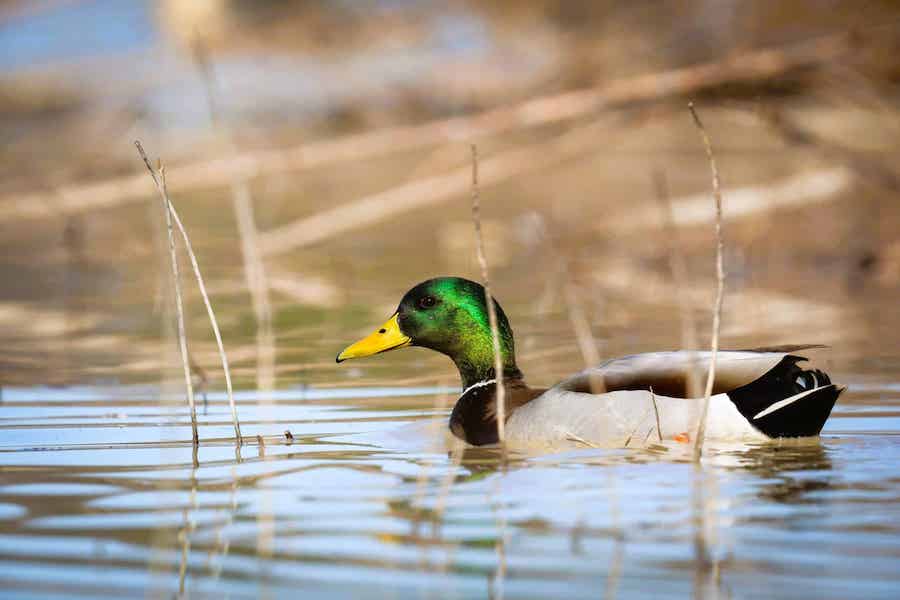The Arkansas Game and Fish Commission’s December aerial waterfowl survey confirmed what many hunters and other observers were believing was the case in terms of the state’s early-season duck numbers: They’re at a modern-day low, both in estimated numbers of mallards and total ducks.
The well-below-average count is attributed to no substantial rainfall to alleviate the months of drought conditions in the Delta, and weather conditions north of Arkansas in late fall have been unseasonably mild all the way to Canada.

By Jim Harris
Managing Editor Arkansas Wildlife Magazine

Brett Leach, the AGFC’s waterfowl program coordinator, also noted that the lower mallard numbers are not a surprise — the 2023 mallard breeding population estimate of slightly over 6 million was the lowest estimate since 1993. “A lot happens between a mallard leaving the Prairie Pothole Region breeding grounds and arriving in Arkansas. Nonetheless, declining continental duck populations should be expected to impact wintering counts and harvest, and that could be starting to show up in this month’s survey estimates,” he wrote in the survey released on Tuesday this week. It should be noted that waterfowl reports from Mississippi (down 68 percent) and Louisiana state agencies reflect significant drops in December waterfowl counts from their long-term averages, again with dry conditions cited as the biggest culprit. Missouri also started slowly, but its numbers in conservation areas recently have increased to more along its December average.
“If you just look at the habitat across all the southern states right now — Arkansas, Mississippi, Louisiana we’re all facing really dry conditions and we’re all season low numbers for our waterfowl counts,” Leach said Wednesday. “And also, north of us it’s been pretty mild. I was checking back home in Wisconsin over the last month and they’re 10-15 degrees warmer than what they’re typically seeing. They’re seeing that in the Dakotas, Missouri, Iowa, pretty much everywhere.”
AGFC biologists Jason Carbaugh, Jason Jackson, Cameron Tatom and Alex Zachary conducted the survey Dec. 4-11, flying over the Mississippi Alluvial Valley (the Delta), the Arkansas River Valley and southwest Arkansas. Biologists conducting transect-based surveys in the Delta estimated 449,860 total ducks, 79,365 of which were mallards. The Delta mallard population estimate was roughly 250,000 ducks below the 2009-2023 long-term December average and the lowest December estimate since the inception of transect-based surveys in 2009. Total duck population estimates were also at an all-time low.
The survey also reported 17,878 ducks estimated in the Arkansas River Valley, including 9,920 mallards, which is near average, though total ducks were slightly below average. Biologists performing cruise surveys in southwest Arkansas reported an estimated 35,857 total ducks (slightly above average for December) with 4,517 mallards (below long-term average).
Also, arctic goose population estimates totaled 622,532 light (lesser snow and Ross’s) geese and 188,402 greater white-fronted geese in the Delta. Biologists noted 4,500 light geese and 1,000 greater white-fronted geese in southwest Arkansas.
A 2-inch rain fell Dec. 1 throughout parts of the Delta, which was the most rainfall since a late October storm that dropped about 4 inches of rain statewide. The good news for waterfowl habitat in the state is that several days of rain are forecast Friday through Christmas Day (Monday).
AGFC staff will conduct its annual Midwinter Waterfowl Survey the first week of January. The third and final aerial survey of the season follows two weeks later.
* * *
It is important to note that not only are these numbers estimates, they are based on randomly selected flight transects. Leach noted that while the transects did not include Lake Ashbaugh in this survey, he and Carbaugh still flew over the popular duck destination and estimated about 80,000 ducks on the water there. They also saw other large duck congregations on other reservoirs.
Leach said the standard error of the mallard population estimate is 20,436, meaning the true population in the Delta could range from 53,246 to 150,170 mallards. Total duck population estimates had a standard error of 81,424, with a true population between 364,613 to 804,666 ducks.
Typically, mallards account for about 52 percent of all ducks in the Delta during December surveys; in this survey, mallards accounted for 18 percent of all ducks in the Delta.
The highest mallard and total duck estimates were in the Bayou Meto-Lower Arkansas and Cache survey zones. About 55 percent of all ducks, including mallards, were in these two survey zones. During this survey period, higher mallard estimates were also in the Black River-Upper White and L’ Anguille survey zones. Hotspot maps show few duck concentration areas outside these survey zones. The low mallard numbers in the Lower White survey zone were surprising, as this area is usually majority mallards during most surveys, but mallards only made up 7 percent of total ducks within this survey zone.
The highest mallard and total duck estimates in the Arkansas River Valley were in the Point Remove-Plumerville survey zone, with estimates in the East Dardanelle zone a distant second. Concentration maps highlight key concentration areas in the Blackwell Bottoms.
So the hope among waterfowlers is for rain and colder weather in Arkansas in coming days and weeks. “That’s what I’m hoping for right now,” Leach said. “Fingers are crossed.”


